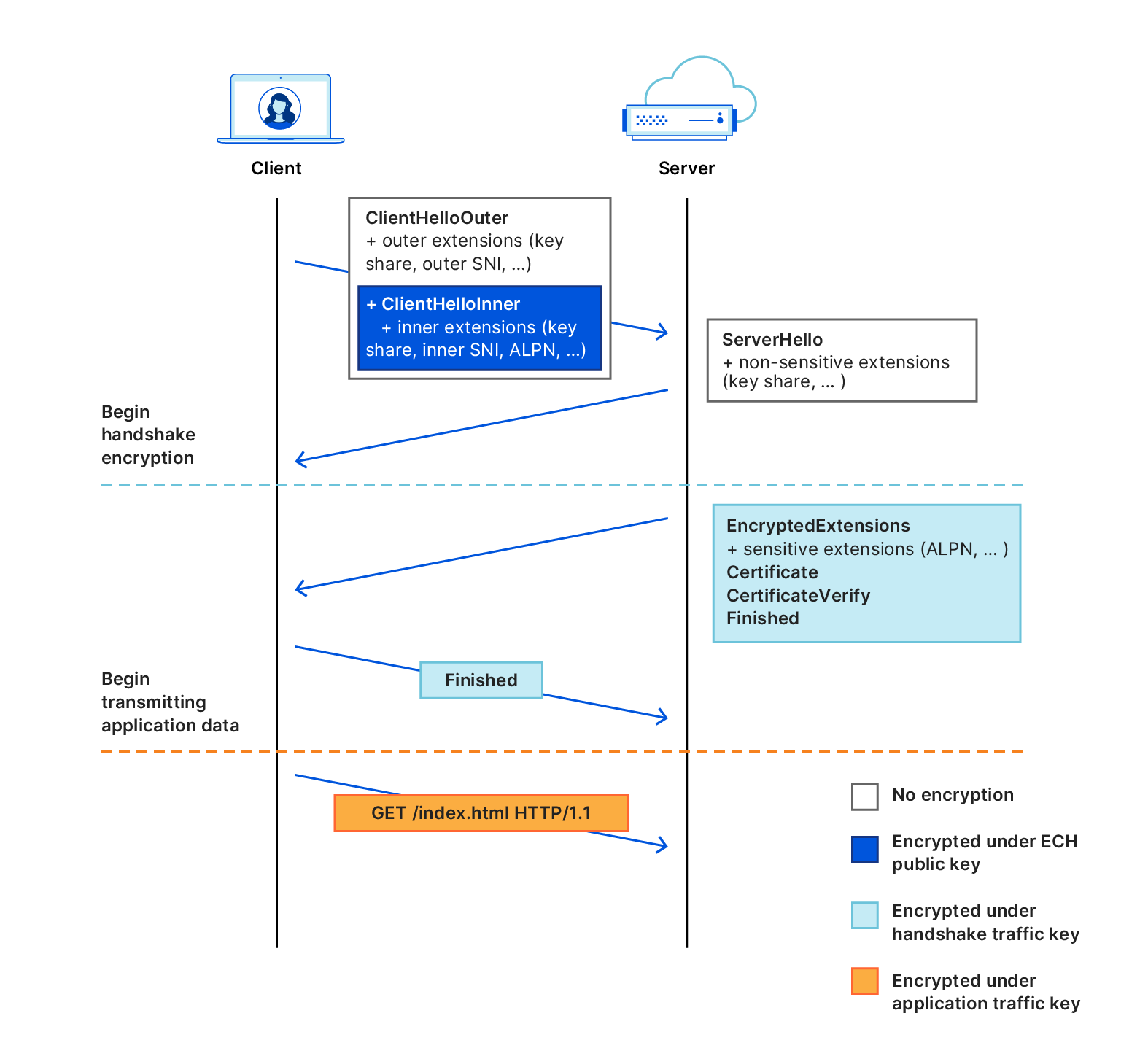As part of the DEfO project, we have been working on accelerating the development Encrypted Client Hello (ECH) as standardized by the IETF. ECH is the next step in improving Transport Layer Security (TLS). TLS is one of the basic building blocks of the internet, it is what puts the S in HTTPS. The ECH standard is nearing completion. That is exciting because ECH can encrypt the last plaintext TLS metadata that it is possible to encrypt. So ECH will bring some real improvements in privacy and censorship resistance.
ECH is built on top of TLSv1.3 and completes unfinished work from the TLSv1.3 effort, now that private DNS is a thing. ECH is now in draft-13 and there are many implementations that are interoperating. ECH is working for OpenSSL, BoringSSL, nginx, Apache HTTPD, lighttpd, HAProxy, Conscrypt, curl, and more. There is work underway in Firefox and Chromium. It has been sketched out for OkHTTP. Draft versions of ESNI and ECH have been deployed in Firefox releases and some production web services.
The main downside of ECH is that it is complex, and most of that is unavoidable. Large scale websites have complicated server-side setups, and ECH has to work in those setups. That is where ECH’s complexity comes from. DNS SVCB and HTTPS RR Types is a related standard to encapsulate the complexity of large scale websites a single DNS lookup. It adds additional complexity since it might include the TCP port number for the service, while TLS implementations mostly assume that the port number is known before doing a DNS lookup.
ECH was formerly known as Encrypted SNI (ESNI), which it replaces. So do not expect updates to ESNI unless ECH proves too complicated for implementers. ECH is more complex to implement in the TLS library than ESNI. Once it is implemented in the TLS library, then implementing the next level of managing the keys and hostnames is quite similar between ESNI and ECH. The rest of this post will be diving into details about that complexity and what it takes to implement ECH.

Do Not Stick Out
ECH implementers must also work to ensure that their implementation does not create packets that look look different than other implementations. How ECH is implemented will affect fingerprintability. Right now, BoringSSL, OpenSSL, and Firefox all put the ECH extension in different places, so it is easy for a network observer to tell which of them is serving as the client in a TLS session. Ideally, all implementations would create network packages that look identical to the network observer. To get an idea of this problem in the real world, see this detailed technical discussion of metadata ordering in DTLS as used in WebRTC.
Getting the keys
ECH encrypts the first stage of the negotiation between the client and server, the ClientHello packet using a new type of key and related configuration. This is known as an “ECH Config”. This negotiation is what sets up the encrypted TLS connection, so to encrypt the negotiation, so the keys can not be derived from the certificates and negotiation itself. ECH also needs new methods distributing this ECH Config. HTTPS/SVCB therefore includes ECH Config Lists, and DNS is the recommended way to get ECH Config Lists. Other distribution methods are also possible, and ECH implementation should provide a method to directly supply ECH Config Lists.
When using ECH in conjunction with HTTPS/SVCB, the DNS needs to be handled differently than the common, decades old practices that most TLS stacks are built on. The ECH Config List must match the IP address so that multi-CDN setups still work. That ensures the server gets the ECH Config that matches its ECH private keys, not the one for a separate server. If the A/AAAA lookup is done separately from the HTTPS/SVCB lookup, they might not match since the results could come from different caches, etc. It is not yet clear where the right place to handle that DNS is, but it is clear that clients that implement HTTPS/SVCB and ECH will need to consider that DNS will touch different parts of the stack.
Which part of the stack will handle the HTTPS/SVCB look up depends on whether the code is acting as a library or more as the client itself. For example, libraries like OkHTTP or Conscrypt can both act as a TLS library, providing the blocks for implementing TLS in an app. They can also act as the TLS client itself, the app just needs to open the hostname and port to get a connection. This is especially true for OkHTTP, which can also handle DNS itself with its own DNS-over-HTTPS implementation. Most apps will expect to just open a URL and have it work without providing anything else. In the case of HTTP libraries like OkHTTP or Volley, Conscrypt becomes the provider of TLS functions rather than the client. OkHTTP’s default setup will probably want to treat Conscrypt like the client and do zero config. But there are use cases where apps want to handle DNS in OkHTTP, in that case Conscrypt is a library. Another way this could be broken down would be to have Conscrypt only be the TLS library, then leave the DNS to the HTTP stacks. Then each HTTP library would have to have their own ECH and HTTPS/SVCB handling (In Android, that would mean HttpURLConnection, OkHTTP, Volley, Apache HTTP Client, etc). Python provides another example with HTTP libraries like Requests working in combination with the core ssl module.
One thing that is clear here: whichever piece initiates the HTTPS/SVCB DNS query should also handle the ECH Config, and setting up the lower levels. On top of this, ECH has GREASE and “Retry Configs”. GREASE is a key part of ensuring that ECH connections do not stick out. GREASE makes the network observer see TLS packets that look the same as connections that successfully used an ECH Config to encrypt. Retry Configs are sent by the server if it cannot decrypt what the client sent. Whichever piece of the code handles the ECH Config List should then also handle GREASE and the Retry Configs.
Outer and Inner ClientHello
This post began by saying that ECH was complex. Most of that complexity stems from the concept of ClientHelloOuter and ClientHelloInner. They are sort of parallel versions of the TLS ClientHello, with ClientHelloOuter being plaintext and ClientHelloInner being encrypted. Many of the same bits of metadata can be set in either ClientHelloOuter or ClientHelloInner, or even in both. And the outer and inner values can be different. For example, the outer plaintext SNI could be set to a generic domain name, while the inner could be set to a different domain name that the client wants to protect. Whenever the client needs to manage what is set in “inner”, “outer”, etc., then extra complexity is exposed all the way up to the app using the ECH client. Also, so many possible configuration options also means so many ways that the negotiation might fail.
BoringSSL’s SSL_set1_ech_config_list() provides a good example of this complexity:
If a supported ECHConfig is found, ssl will encrypt the true ClientHello parameters. If the server cannot decrypt it, e.g. due to a key mismatch, ECH has a recovery flow. ssl will handshake using the cleartext parameters, including a public name in the ECHConfig. If using SSL_CTX_set_custom_verify, callers should use SSL_get0_ech_name_override to verify the certificate with the public name. If using the built-in verifier, the X509_STORE_CTX will be configured automatically.
If no other errors are found in this handshake, it will fail with SSL_R_ECH_REJECTED. Since it didn’t use the true parameters, the connection cannot be used for application data. Instead, callers should handle this error by calling SSL_get0_ech_retry_configs and retrying the connection with updated ECH parameters. If the retry also fails with SSL_R_ECH_REJECTED, the caller should report a connection failure.
A walk through which pieces needs to do what
Let us return to the Python example to go through the pieces needed to implement ECH there. Starting at the lowest level, the Python ssl is built on top of OpenSSL, so the new ECH functions in OpenSSL need to be included and exposed in ssl’s API. Unlike with a plain TLSv1.3 connection, ssl would not set up an ECH connection without additional configuration as long as ssl does not include the additional DNS requirements needed to fetch the ECH Config. The DNS could instead be implemented in the HTTP library. Requests is built on top of urllib3, so urllib3 could implement HTTPS/SVCB handling. Then Requests would automatically get ECH connections. Since it can be necessary to handle the ECH Config outside of DNS, urllib3 and Requests could provide methods for the app to submit the ECH Config. This would mean overriding any HTTPS/SVCB handling in Requests and urllib3.
Based on this outline, these are the pieces that need to be implemented:
- HTTPS/SVCB DNS queries for getting ECH Config Lists, IP, and other config.
- A way to provide ECH Config Lists as bytes directly to the ssl module.
- A method to ensure encrypted DNS is used so all metadata is encrypted.
- A method to enable and disable GREASE, ideally with GREASE default on.
- A callback that gets called whenever ECH negotiation fails and the server offers a “Retry Config”.
- Potentially also controls of what to send in the ClientHelloOuter versus the ClientHelloInner.
From the point of view of the client implementation, there is a big difference between TLS before and after ECH. This new complexity may look scary but this is a clear path to providing strong privacy protections with TLS that can be as widely deployed as TLSv1.3 is now.
